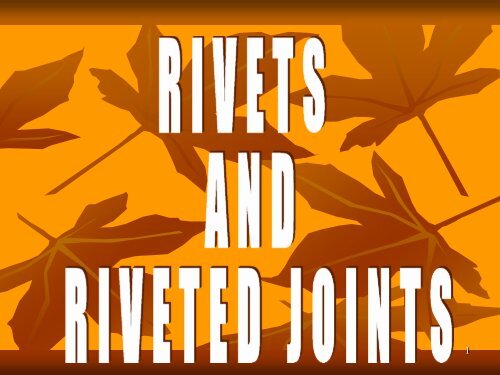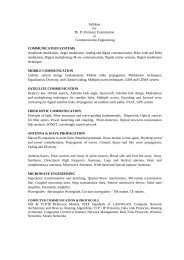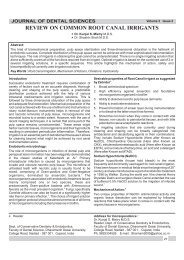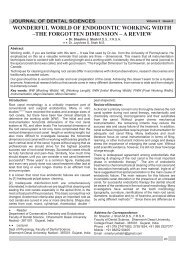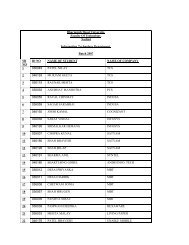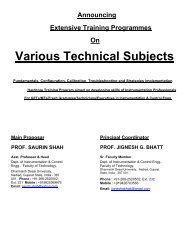Chapter-3A_MDID.pdf
Chapter-3A_MDID.pdf
Chapter-3A_MDID.pdf
You also want an ePaper? Increase the reach of your titles
YUMPU automatically turns print PDFs into web optimized ePapers that Google loves.
Rivet<br />
Types of rivets<br />
Rivet symbols<br />
Conventional representation<br />
Riveting<br />
Caulking and fullering<br />
Nomenclature<br />
RIVETS & RIVETED JOINTS<br />
Proportions of riveted joints<br />
Classification of riveted joints<br />
2<br />
2
Rivets are short cylindrical pieces of ductile metal<br />
having a head at one end and slightly tapered tail<br />
on the other end<br />
The portion of a rivet between the head and the<br />
tail is called shank<br />
RIVET<br />
3
Used to join two or more pieces of sheet metals<br />
permanently, plates to rolled sections, rolled<br />
section to each other etc…<br />
Mild steel, wrought iron, copper and Aluminium<br />
alloys are some of the metals commonly used for<br />
rivets<br />
Rivets are used for joining of sheets and plates in<br />
bridges, boilers, storage tanks, pressure vessels<br />
and ships etc…<br />
RIVET<br />
4
Following types of rivets are used for different work<br />
(1) Structural rivets (12 to 45mm dia.):<br />
(2) Boiler rivets (12 to 50mm dia.)<br />
(3) Small rivets (2 to 10mm dia.)<br />
(1) Structural rivets (12 to 45mm dia.): Used for<br />
structural work<br />
TYPES OF RIVETS<br />
Snap Head Pan Head Pan Head with<br />
Tapered neck<br />
Round countersunk<br />
Head<br />
Countersunk<br />
Head<br />
5
(2) Boiler rivets (12 to 50mm dia.): Used for boiler<br />
works<br />
TYPES OF RIVETS<br />
Snap Head Pan Head<br />
Pan head 1 Conical Head<br />
Ellipsoidal<br />
6
TYPES OF RIVETS<br />
(2) Small rivets (2 to 10mm dia.): Used for general<br />
purposes and are of steel brass or aluminium<br />
Flat Head<br />
0.75d<br />
Mushroom Head<br />
1.75d<br />
Round Head<br />
Countersunk Head<br />
7
RIVET SYMBOLS<br />
In case of large drawings where no. of rivets are<br />
used, it is not necessary to draw all rivets<br />
For this, gauge lines are drawn and location of<br />
rivets are shown by line symbol as per I.S.I.<br />
8
RIVET SYMBOLS<br />
Rivet symbols as per B.I.S. are given below<br />
9
CONVENTIONAL REPRESENTATION AS PER B.I.S<br />
In case of large drawings where number of rivets are used,<br />
gauge lines are drawn and location of rivets and holes are<br />
shown by line symbols<br />
Various symbols for hole according to B.I.S. S.P.:46-1988<br />
are given below<br />
HOLE<br />
10
CONVENTIONAL REPRESENTATION AS PER B.I.S<br />
Various symbols for rivets according to B.I.S. S.P.:46-1988<br />
are given below<br />
RIVET<br />
11
RIVETING<br />
The process of joining two or more plates by<br />
means of rivets is called riveting<br />
12
During riveting, rivet head is formed from the tail<br />
of the rivet places in the rivet holes drilled in the<br />
plates to be fastened<br />
Forming of head may be either by hand tools or<br />
by machines<br />
RIVETING<br />
In machine riveting, force is applied by means of<br />
hydraulic or pneumatic pressure<br />
13
CAULKING AND FULLERING OPERATIONS<br />
To obtain leak proof joints, the edges of the<br />
plates to be joined and the rivet heads are forced<br />
to gether by caulking and fullering operations<br />
CAULKING<br />
Caulking plate<br />
The outer edges of the plates are bevelled<br />
These bevelled edges of the plates are caulked<br />
Caulking is an operation in which the outer bevelled edges<br />
of the plates are hammered and driven-in by a caulking tool<br />
The caulking tool is in the form of a blunt edged chisel<br />
14
CAULKING AND FULLERING OPERATIONS<br />
FULLERING<br />
Similar to caulking, fullering is also used to<br />
produce air tight joints.<br />
Unlike the caulking tool, the width of the fullering<br />
tool is equal to the width of the bevelled edges of<br />
the plates<br />
15
NOMENCLATURE OF RIVETED JOINTS<br />
Important terms used in riveted joints are<br />
defined below<br />
Rivet diameter is represented by ‘d’ and plate<br />
thickness is represented by ‘t’<br />
16
NOMENCLATURE OF RIVETED JOINTS<br />
Gauge line: It is a line through the centers of a<br />
row of rivets and parallel to the edge of the plate<br />
17
NOMENCLATURE OF RIVETED JOINTS<br />
Pitch: It is a the distance from the centre of the<br />
rivet to the centre of the next rivet in the same<br />
row measured on the gauge line<br />
It is also called longitudinal pitch<br />
It is represented by p<br />
18
NOMENCLATURE OF RIVETED JOINTS<br />
Transverse pitch: It is a the distance between<br />
adjacent gauge lines in the same plate.<br />
It is also called back pitch or row pitch<br />
It is represented by p t<br />
19
NOMENCLATURE OF RIVETED JOINTS<br />
Diagonal pitch: It is a the distance between the<br />
centres of adjacent rivets on adjacent gauge lines<br />
in the same plate<br />
It is represented by p d<br />
20
NOMENCLATURE OF RIVETED JOINTS<br />
Margin: It is the distance from the edge of the<br />
plate to the entre of the nearest rivet hole<br />
It is represented by m<br />
21
PROPORTIONS OF RIVETED JOINTS<br />
The dimensions of joint depends upon properties<br />
of plate and rivet material<br />
However, if thickness of plate (t) is known the<br />
diameter (d) can be found using Unwin’s formula<br />
d6<br />
Standard diameters of rivets as per B.I.S. are<br />
shown in the table<br />
t<br />
22
PROPORTIONS OF RIVETED JOINTS<br />
Other proportions as per B.I.S. are shown in the<br />
table<br />
23
CLASSIFICATION OF RIVETED JOINTS<br />
Depending upon the manner of placing the plates,<br />
riveted joints are classified in to two types<br />
(a) Lap joint and<br />
(b) Butt joint<br />
Lap joint Butt joint<br />
24
CLASSIFICATION OF RIVETED JOINTS<br />
Depending upon no. of rows of rivets in a joint,<br />
riveted joints are divided into two types<br />
(a) Single riveted joint and<br />
(b) Multiple riveted joint<br />
(i) Double riveted<br />
(ii) Triple riveted<br />
(iii) Quadruple riveted etc…<br />
25
CLASSIFICATION OF RIVETED JOINTS<br />
SINGLE RIVETED JOINT<br />
26
CLASSIFICATION OF RIVETED JOINTS<br />
DOUBLE RIVETED JOINT<br />
27
CLASSIFICATION OF RIVETED JOINTS<br />
Depending upon arrangement of rivets in<br />
adjacent rows, riveted joints are classified as;<br />
(a) Chain riveted joint and<br />
(b) Zig-zag riveted joint<br />
28
CLASSIFICATION OF RIVETED JOINTS<br />
CHAIN RIVETED JOINT<br />
29
CLASSIFICATION OF RIVETED JOINTS<br />
ZIG-ZAG RIVETED JOINT<br />
30
CLASSIFICATION OF RIVETED JOINTS<br />
Riveted joints may also be classified as;<br />
(a) Structural joints and<br />
(b) Pressure vessel joints<br />
Angle Joint<br />
31
CLASSIFICATION OF RIVETED JOINTS<br />
Column and Beam Joint<br />
32
CLASSIFICATION OF RIVETED JOINTS<br />
Built up girder<br />
33


